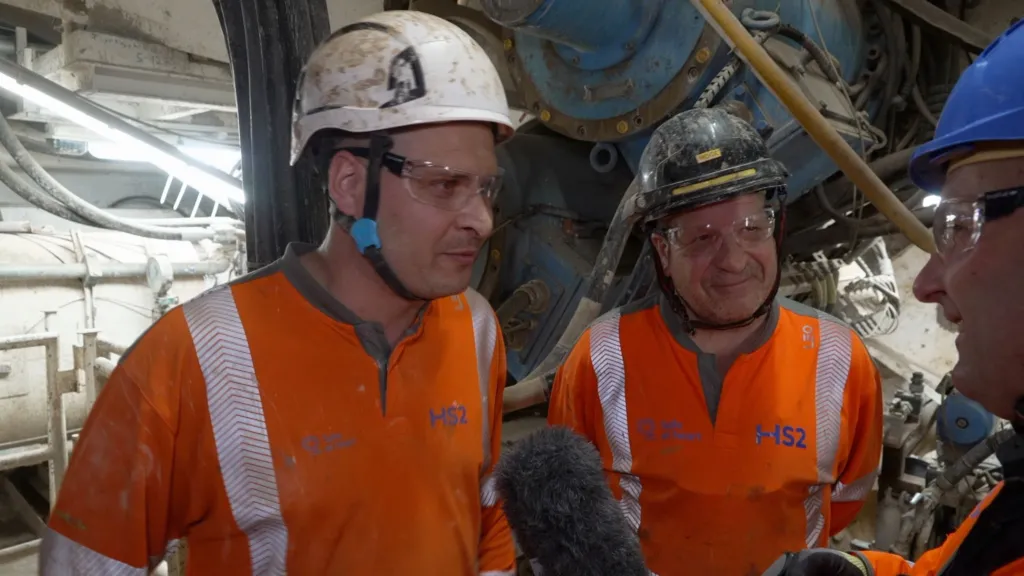It is a noisy, dusty environment, situated about 30 meters (approximately 98 feet) beneath the surface—welcome to the realm of the London miner.
We find ourselves aboard a tunnel boring machine (TBM) within the expansive Northolt tunnels associated with High Speed Two.
These TBMs are a major part of a tunneling revival that’s transforming London, much of it out of sight.
They have previously served to excavate the Silvertown Tunnel, Crossrail, the Power Tunnels in northern London, the Thames Tideway super sewer, and the Channel Tunnel.
Teams of miners, hailing from various corners of the globe, operate these machines, frequently transitioning between different projects.
This group of miners tends to be quite humble, often regarding their work as entirely normal.
Working shifts that last anywhere from seven to twelve hours, the TBM operates without interruption, advancing at a rate of 16 meters (around 52 feet) per day, 24/7.
Graham Clark and his son Liam are originally from Kent.
Graham shares that his journey into mining began with the Channel Tunnel: “I was simply asked if I’d like to join as a local laborer.”
After six years dedicated to the Channel Tunnel, he continued in the field.
Liam credits his father with introducing him to the trade.
“My old man brought me into it. I had just finished school when I received a call. He was working away at the time and said, ‘You’re starting with me tomorrow.’
“And that was it. I’ve been working away from home ever since. It’s been around 14 years now.”
Graham believes it’s a fulfilling profession.
“It has its challenges and can be demanding, but with a solid crew, everyone collaborates and supports one another. Each job brings different hurdles, but overall, it’s rewarding.”
The mining workforce is quite diverse, comprised of individuals from various countries.
Jack Doherty, like many of his colleagues, comes from Donegal in Ireland. He notes the similarities to any other construction site.
“There’s a robust tunneling community where I’m from,” Jack explained. “Many of the younger guys here have fathers in the trade—it tends to be a family tradition in my area.”
At the entrance of every tunnel, a small shrine dedicated to Saint Barbara, the patron saint of miners, can be found.
Traveling to the boring machine involves a one-hour ride in a buggy through the tunnel, where temperatures can rise significantly.
As it stands, the Northolt tunnels are approximately 93% complete.
We arrived just before they were set to break through to the shaft at Greenford.
Four machines were nearing the shaft from both the southeast and northwest, equipped with massive conveyor belts transporting spoil along the tunnel.
Once their work is finished, these machines will be extracted and decommissioned.
Michael Greiner, who oversees tunneling at SCS JV, was present. I had met him earlier at the project’s inception, where he highlighted that “while many aspects have progressed smoothly, tunneling does bring its exciting elements,” especially due to the area’s “quite heterogeneous” geology.
He explained: “We are excavating through the London Basin, encountering a mix of chalk, flint, and sand.
“The geological surprises make it unpredictable, adding to the ongoing challenges.”
The TBMs are intricate machines, and various ground conditions have created hurdles.
Within the vicinity of Ruislip Rugby Club, they encountered sandy terrain, leading to significant amounts of foam appearing on the rugby fields, which subsequently had to be closed off.
At that time, Jatin Radia, the chair of the rugby club, expressed concerns: “This understandably raises worries among local residents and rugby club members, as they wonder, ‘Is it safe?’”
Following a brief halt, drilling resumed.
For the most part, as per HS2’s head of delivery, James Leeming, the majority of those above ground remained oblivious to what was taking place beneath them.
“Many residents in west London may have had 25 meters (about 82 feet) of tunneling happening directly beneath their homes and streets, and they remained unaware of the operations below,” he remarked.
He believes the tunneling progress thus far is a positive indicator for the eventual completion of the tunnel to Euston.
“It’s highly encouraging to have accomplished so much on this section, but there’s still a considerable amount of work ahead this year. It promises to be one of our most productive periods concerning civil contracts.
“This truly positions us well for the successful delivery of the Euston Tunnel.”

